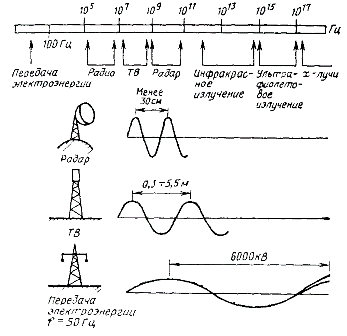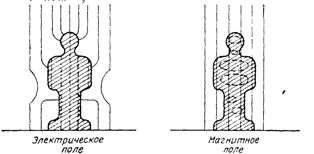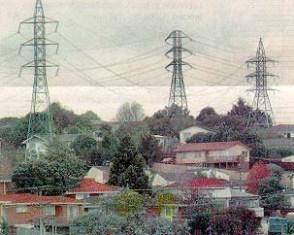How electromagnetic fields from overhead power lines affect people, animals and plants
The biological influence of electric and magnetic fields on the organism of humans and animals has been studied a lot. The observed effects, if they occur, are still unclear and difficult to define, so this topic remains relevant.
The magnetic fields of our planet have a dual origin — natural and anthropogenic. Natural magnetic fields, so-called magnetic storms, originate in the Earth's magnetosphere. Anthropogenic magnetic disturbances cover a smaller territory than natural ones, but their manifestation is much more intense and therefore brings more tangible damage. As a result of technical activity, man creates artificial electromagnetic fields that are hundreds of times stronger than the Earth's natural magnetic field. Sources of anthropogenic radiation are: powerful radio transmitting devices, electrified vehicles, power lines.

Frequency range and wavelengths of some sources of electromagnetic radiation
One of the most powerful pathogens electromagnetic waves — industrial frequency currents (50 Hz).So the strength of the electric field directly under the power line can reach several thousand volts per meter of soil, although due to the property of reducing the voltage from the soil, already at a distance of 100 m from the line, the intensity drops sharply to several tens of volts per meter.
Studies of the biological effect of an electric field have established that even at a strength of 1 kV / m, it has an adverse effect on the human nervous system, which in turn leads to disruption of the endocrine apparatus and metabolism in the body (copper, zinc, iron and cobalt), disrupts physiological functions: heart rate, blood pressure, brain activity, metabolic processes and immune activity.

Since 1972, publications have appeared in which the effect on humans and animals of electric fields with an intensity above 10 kV / m is considered.
Magnetic field strength proportional to current and inversely proportional to distance; electric field strength is proportional to voltage (charge) and inversely proportional to distance. The parameters of these fields depend on the voltage class, design features and geometric dimensions of the high voltage power line. The appearance of a powerful and extended source of electromagnetic field leads to a change in those natural factors that formed the ecosystem. Electric and magnetic fields can induce surface charges and currents in the human body.
Studies show that the maximum current in the human body induced by an electric field is much higher than the current caused by a magnetic field.Thus, the harmful effect of a magnetic field manifests itself only at its strength of about 200 A / m, which occurs at a distance of 1-1.5 m from the phase line wires and is dangerous only for service personnel when working under voltage. This circumstance made it possible to conclude that there is no biological effect of industrial frequency magnetic fields on people and animals under power lines. Thus, the electric field of power lines is the main biologically effective factor for extended energy transmission, which can become a barrier to the movement of various species of aquatic and terrestrial fauna.

Power lines of electric and magnetic fields affecting a person standing under an overhead AC power line
Based on the design features of power transmission (conductor sag), the greatest influence of the field occurs in the middle of the section, where the voltage for super- and ultra-high voltage lines at the height of a person is 5 — 20 kV / m and higher, depending on the voltage class and line design.
At the supports, where the height of the suspension of the wires is the greatest and the shielding effect of the supports affects, the field strength is the smallest. Since people, animals, transport can be under the wires of power lines, it becomes necessary to evaluate the possible consequences of long and short-term stay of living beings in an electric field of different strength.
The most sensitive to electric fields are ungulates and people in shoes that isolate them from the ground. Animal hoofs are also good insulators.In this case, the induced potential can reach 10 kV, and the current pulse through the body when touching a grounded object (bush branch, blade of grass) is 100-200 μA. Such current pulses are safe for the body, but the discomfort makes ungulates avoid high-voltage power lines in the summer.
In the action of an electric field on a person, the currents flowing through his body play a dominant role. This is determined by the high conductivity of the human body, where organs with blood and lymph circulating in them predominate.
At present, experiments on animals and human volunteers have established that the current density with a conductivity of 0.1 μA / cm and lower does not affect the work of the brain, since the pulsed biocurrents, normally flowing in the brain, significantly exceed the density of such a current of conductivity.
At a current density of 1 μA / cm, flickering of light circles is observed in the eyes of a person, higher current densities already capture the threshold values of stimulation of sensory receptors, as well as nerve and muscle cells, which leads to fear and involuntary motor reactions.
In the event that a person touches objects isolated from the ground in the area of an electric field of significant intensity, the current density in the area of the heart strongly depends on the state of the basic conditions (type of shoes, condition of the soil, etc.), but it can already reach these values.
At the maximum current corresponding to Emax == 15 kV / m (6.225 mA), a certain part of this current flowing through the head area (about 1/3), and the head area (about 100 cm), the current density< 0.1 μA / cm, which confirms the admissibility of the accepted strength of 15 kV / m under the overhead line conductors.
For human health, the problem is to determine the relationship between the current density induced in the tissues and the magnetic induction of the external field, V. Calculating the current density

it is complicated by the fact that its exact path depends on the distribution of conductance y in the body's tissues.
So the specific conductance of the brain is determined in=0.2 cm / m, and the heart muscle in=0.25 cm / m. If the radius of the head is 7.5 cm, and the radius of the heart is 6 cm, then the product yR turns out to be the same in both cases. Therefore, one representation of the current density in the periphery of the heart and brain can be given.
It has been determined that the magnetic induction safe for health is about 0.4 mT at a frequency of 50 or 60 Hz. In magnetic fields (from 3 to 10 mTl, f = 10 — 60 Hz), the appearance of slight oscillations, similar to those that occur when the eyeball is pressed, is observed.
The current density induced in the human body by an electric field of intensity value E is calculated as follows:

° With different k coefficients for the brain and heart region.
The value of k =3-10-3 cm / Hzm.
According to German scientists, the field strength at which the vibration of the hair is felt by 5% of the tested men is 3 kV / m, and for 50% of the tested men it is 20 kV / m. There is currently no evidence that the sensations caused by the action of the field create any adverse effect. Regarding the relationship between current density and biological influence, four areas can be distinguished, presented in the table.
J, μA / cm Observed effects 0.1 No 1.0 Flickering light circles in the eyes 10-50 Acute neuralgic symptoms similar to those caused by an electric shock more than 100 Increased likelihood of ventricular fibrillation, cardiac arrest, prolonged spasm of respiratory muscles, severe burns
The latter region of the current density value refers to exposure times on the order of one cardiac cycle, i.e. approximately 1 s per person. For shorter exposures, the threshold values are higher. In order to determine the threshold value of the field strength, physiological studies were carried out on people in laboratory conditions at a strength of 10 to 32 kV / m. It was found that at a voltage of 5 kV / m, 80% of people do not feel pain during discharges when touching grounded objects. It is this value that is accepted as normative when working in electrical installations without the use of protective means.
The dependence of the permissible time of a person's stay in an electric field with an intensity E greater than the threshold is approximated by the equation

The performance of this state ensures self-restoration of the physiological state of the body during the day without residual reactions and functional or pathological changes.
Let's get acquainted with the main results of research into the biological effects of electric and magnetic fields conducted by Soviet and foreign scientists.
Effects of electric fields on personnel
During the studies, an integrating dosimeter was attached to the upper forearm of each worker.The average daily exposure for workers on high voltage lines was found to range from 1.5 kV/(m-h) to 24 kV/(m-h). Maximum values are noted in very rare cases. From the data obtained from the study, it can be concluded that there is no discernible relationship between field exposure and the general state of human health.
Overhead power lines and childhood cancer
In residential premises magnetic field can be created by household electrical equipment and wiring, outdoor underground cables, and overhead power lines. Study and control sites were clustered at 25 m intervals next to the overhead power line, with the degree of risk at a distance of more than 100 m from the line taken as unity.
These results do not support the hypothesis that power frequency magnetic fields influence the occurrence of cancer in children.

Electrostatic effect on human and animal hair
The study was conducted in connection with the hypothesis that the influence of the field felt by the surface of the skin is caused by the action of electrostatic forces on the hair. As a result, it was found that at a field strength of 50 kV / m, the subject felt itching associated with hair vibrations, which was recorded with special devices.
Electric field effect on plants
The experiments were conducted in a special chamber in an undistorted field with an intensity of 0 to 50 kV/m. Slight damage to leaf tissue was found at exposures of 20 to 50 kV/m, depending on plant configuration and initial moisture content. Tissue necrosis was observed in plant parts with sharp edges.Thick plants with a smooth rounded surface are not damaged at a voltage of 50 kV / m. The damage is the result of the crown on the protruding parts of the plant. In the weakest plants, the damage is observed 1-2 hours after the exposure. Importantly, in wheat seedlings with very sharp ends, the crown and damage were noticeable at a relatively low voltage of 20 kV/m. This is the lowest threshold for impairment in studies.
The most likely mechanism of plant tissue damage is thermal. Tissue damage occurs when the field strength becomes high enough to cause corona, and a high-density corona current passes through the tip of the leaf. The heat released in this case across the resistance of the leaf tissue results in the death of a narrow layer of cells , which relatively quickly lose water, dry out and shrink. However, this process has a limitation and the percentage of the dried surface of the plant is small.
The effect of the electric field on animals
The research was conducted in two directions: research at the level of the biosystem and research of the thresholds of the detected influences. Among chickens placed in a field with a voltage of 80 kV / m, weight gain, viability and low mortality were noted. Field perception threshold was measured on homing pigeons. Pigeons have been shown to have some mechanism for detecting low-intensity electric fields. No genetic changes were observed. It is noted that animals living in a high-intensity electric field can experience a mini-shock due to external factors, depending on the conditions of the experiment, which can lead to some anxiety and excitement of the tested.
A number of countries have regulations that limit field strength limits in the area of overhead transmission lines. A maximum voltage of 20 kV/m is recommended in Spain, and the same value is currently considered the limit in Germany.
Public awareness of the effect of the electromagnetic field on living organisms continues to grow, and some interest and concern about this effect will lead to continued relevant medical research, especially in people living near overhead power lines.
More information on this topic:
V.I. Chekhov "Environmental Aspects of Electricity Transmission" (to download book — Zip, DjVu)
The book provides a general description of the environmental impact of overhead power lines. The issues of calculating the maximum strength of the electric field under the alternating current line and methods of its reduction, rejection of lands under the route line, the impact of the electromagnetic field on people, flora and fauna from the appearance of radio and acoustic noise are considered. The features of the environmental impact of direct current lines and extra high voltage cable lines are considered.
See also on this topic: Protection of a person from exposure to electromagnetic radiation
